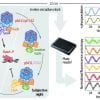Summary: A study of monozygotic twins allowed researchers to discover which parts of immune dysfunction in multiple sclerosis were influenced by genetics, and which were influenced by environmental factors.
Source: University of Zurich
Researchers at the University of Zurich and Munich’s LMU Klinikum hospital have studied the immune system of pairs of monozygotic twins to identify the influence of the environment and of genetics in cases of multiple sclerosis. In the process, they may have discovered precursor cells of the disease-causing T cells.
Multiple sclerosis (MS) is a chronic inflammatory disease of the central nervous system and the most common cause of neurological impairment in young adults. In MS, the patient’s own immune system attacks the brain and spinal cord, resulting in cumulative neurological deficits such as damaged sight, sensory disturbances, motor deficits (e.g. limiting the ability to walk) as well as cognitive impairment.
Although the cause of MS is still unclear, a variety of genetic risk factors and environmental influences have already been linked to the disease.
Genetic predisposition alone does not lead to MS
Studies in recent years have clearly shown that genetic risk variants are a necessary condition for developing multiple sclerosis. “Based on our study, we were able to show that about half of the composition of our immune system is determined by genetics,” says Florian Ingelfinger, a Ph.D. candidate at the UZH Institute of Experimental Immunology.
The study by the team led by immunologist Burkhard Becher, professor at the Institute of Experimental Immunology at UZH, and the research groups of Lisa Ann Gerdes and Eduardo Beltrán of the Institute of Clinical Neuroimmunology at the LMU Klinikum, shows that these genetic influences, while always present in MS patients, are not on their own sufficient to trigger multiple sclerosis.
In the study, the researchers recruited 61 pairs of monozygotic twins where one twin is affected by MS and the co-twin is healthy. From a genetic point of view, the twins were thus identical. “Although the healthy twins also had the maximum genetic risk for MS, they showed no clinical signs of the disease,” says Lisa Ann Gerdes.
Twin study eliminates genetic influences
Thanks to this globally unique cohort of identical twins, the researchers were able to exclude genetic influences by comparing twins with and without multiple sclerosis.
“We are exploring the central question of how the immune system of two genetically identical individuals leads to significant inflammation and massive nerve damage in one case, and no damage at all in the other,” explains Burkhard Becher. Using identical twins enabled the international team of scientists to rule out the genetic influence and specifically track the immune system changes that were ultimately responsible for triggering MS in one twin.
Cutting-edge single-cell technologies and artificial intelligence
The researchers harnessed state-of-the-art technologies to describe the immune profiles of the twin pairs in rich detail. “We use a combination of mass cytometry and the latest methods in genetics paired with machine learning to not only identify characteristic proteins in the immune cells of the sick twin in each case, but also to decode the totality of all the genes that are switched on in these cells,” Florian Ingelfinger explains.
Eduardo Beltrán, an expert in single-cell genomics, adds: “This ensures that we obtain as much information as currently technically possible from these valuable samples.” The team uses a variety of tailored algorithms based on artificial intelligence to extract relevant insights from this immense dataset.
An error in the communication of immune cells
“Surprisingly, we found the biggest differences in the immune profiles of MS affected twins in to be in the cytokine receptors, i.e., the way immune cells communicate with one another. The cytokine network is like the language of the immune system,” says Ingelfinger.

The researchers found that increased sensitivity to certain cytokines leads to greater activation of T cells in the blood of patients with multiple sclerosis. These T cells are more likely to migrate into the central nervous system of patients and cause damage there. The identified cells were found to have the characteristics of recently activated cells, which were in the process of developing into fully functional T cells. “We may have discovered the cellular big bang of MS here—precursor cells that give rise to disease-causing T cells,” says Becher.
Important foundation for understanding the influence of genetics and environment on MS
“The findings of this study are particularly valuable in comparison to previous studies of MS which do not control for genetic predisposition,” says Burkhard Becher. “We are thus able to find out which part of the immune dysfunction in MS is influenced by genetic components and which by environmental factors. This is of fundamental importance in understanding the development of the disease.”
See also

The participating twins were recruited for the study at the LMU Klinikum. “This unique opportunity to unravel the influence of genetics and environment in multiple sclerosis is entirely thanks to our patients who agreed to join the study,” said Lisa Ann Gerdes.
About this genetics and multiple sclerosis research news
Author: Press Office
Source: University of Zurich
Contact: Press Office – University of Zurich
Image: The image is in the public domain
Original Research: Open access.
“Twin study reveals non-heritable immune perturbations in multiple sclerosis” by Burkhard Becher, et al. Nature
Abstract
Twin study reveals non-heritable immune perturbations in multiple sclerosis
Multiple sclerosis (MS) is a chronic inflammatory disorder of the central nervous system underpinned by partially understood genetic risk factors and environmental triggers and their undefined interactions.
Here we investigated the peripheral immune signatures of 61 monozygotic twin pairs discordant for MS to dissect the influence of genetic predisposition and environmental factors.
Using complementary multimodal high-throughput and high-dimensional single-cell technologies in conjunction with data-driven computational tools, we identified an inflammatory shift in a monocyte cluster of twins with MS, coupled with the emergence of a population of IL-2 hyper-responsive transitional naive helper T cells as MS-related immune alterations.
By integrating data on the immune profiles of healthy monozygotic and dizygotic twin pairs, we estimated the variance in CD25 expression by helper T cells displaying a naive phenotype to be largely driven by genetic and shared early environmental influences. Nonetheless, the expanding helper T cells of twins with MS, which were also elevated in non-twin patients with MS, emerged independent of the individual genetic makeup. These cells expressed central nervous system-homing receptors, exhibited a dysregulated CD25–IL-2 axis, and their proliferative capacity positively correlated with MS severity.
Together, our matched-pair analysis of the extended twin approach allowed us to discern genetically and environmentally determined features of an MS-associated immune signature.
Credit: Source link





















